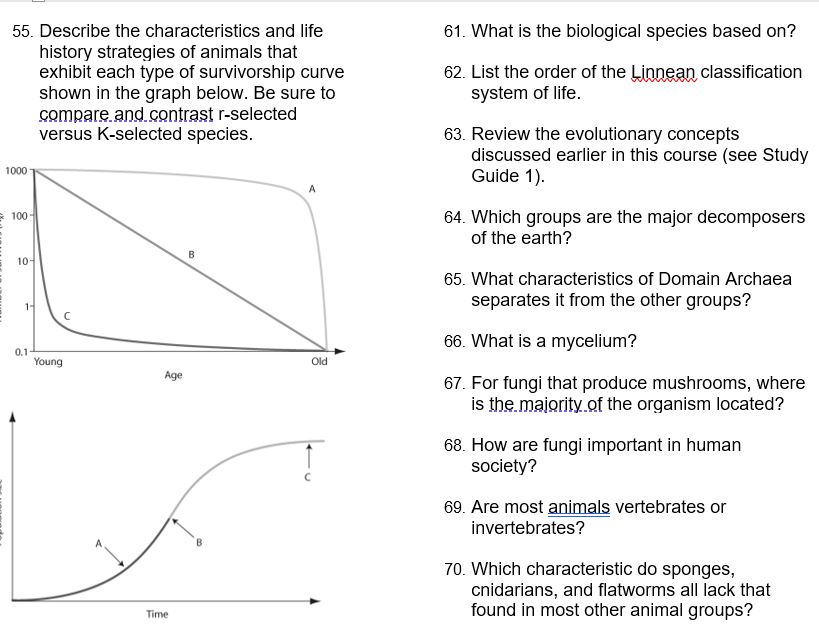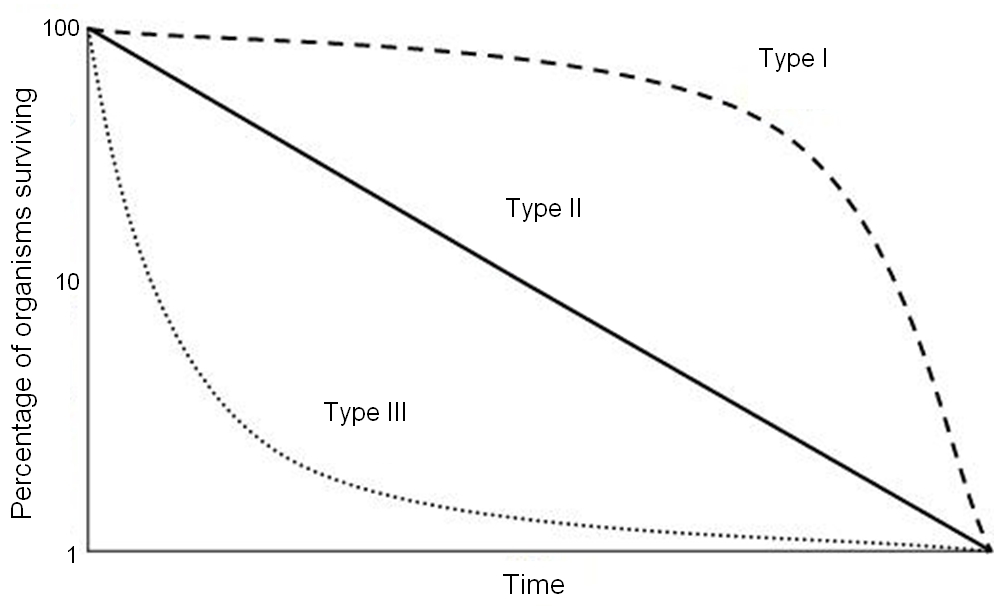Which Curve in the Graph Best Represents a K-selected Species
K-selected species because it has a low number of offspring per reproductive event. In a K-selected species graph the line where the graph levels off is the.

Solved 61 What Is The Biological Species Based On 55 Chegg Com
It can be depicted in a graph.

. Survivorship curve graphic representation of the number of individuals in a population that can be expected to survive to any specific age. A place where an organism naturally lives or grows 1 habitat 4. Possesses various r- and K-selected characteristics but must be considered as a whole.
However the students should be able to identify definitively that the red-tailed hawk is more K-selected than the roadrunner the Western rattlesnake is more K-selected than the Whiptail lizard and that the coyote is more K-selected than the Kangaroo mouse. R-selected species also called r-strategist species whose populations are governed by their biotic potential maximum reproductive capacity r. Reach sexual maturity quickly.
K-selected species B r-selected species C Type I survivorship D Type II survivorship. This relatively flat curve reflects low juvenile mortality with most individuals living to old age. K-selected species have a few offspring that have a long life expectancy.
There are three general types of curves. The middle graph. Discover examples of rK strategies and examine how to graph the growth of r-selected and K-selected species.
The difference between an R-selected species and a K-selected species is that the R-selected species live in variable unstable habitats while K-selected species reside in stable environments. Learn about r-selected vs. Notice that when N is almost zero the quantity in brackets is almost equal to 1 or KK and growth is close to exponentialWhen the population size is equal to the carrying capacity or N K the quantity in brackets is equal to zero and growth is equal to zeroA graph of this equation logistic growth yields the S-shaped curve bIt is a more realistic model of population growth.
These are directional selection disruptive selection and stabilizing selection. R-selected species are. Number of individuals in the species.
It is expected to drop to 05. Distribution of the population. All the animal life of a region 4 flora 2.
D Which curve in the graph best represents a K-selected species. There is three types of natural selections. It can help us to know about various aspects such as life expectancy and age-specified survival of a particular species.
These species tend to have larger but fewer offspring and contribute large amounts of resources to each offspring. For making survivorship curves ecologists identify a cohort which is a group of individuals of the same species in the same population born at the same time. Survivorship curves shows the decline of individuals with age.
It provides information regarding different population parameters like lifespan survival. D increasing numbers of women entering the workforce in developing nations. The Type I curve illustrated by the large mammals tracks organisms that tend to live long lives low death rate and high survivorship rate.
Type III or concave curves have the greatest mortality lowest age-specific survival early in life with relatively low rates of death high probability of survival for those surviving this bottleneck. Elephants would be an example of a K-selected species. Dandelions grow quickly and produce many seeds ensuring that at least some plants will survive and produce seeds themselves which curve best represents the survivorship of dandelions.
Toward the end of their life expectancies however there is a dramatic. R-selected species produce many offspring but only a few live out their lifespan. The dashed line represents the carrying capacity of the species.
This type of curve is characteristic of species that produce a large number of offspring see rK selection theory. A group of interacting individuals of the same species within the same geographic area 2 population. Species that tend to reproduce more slowly as they approach their environments carrying capacity.
Such species make up one of the two generalized life-history strategies posited by American ecologist Robert MacArthur and American biologist Edward O. II survivorship curve as shown in the graph. This includes most marine invertebrates.
Populations of K-selected species tend to exist close to their carrying capacity. Which of the following graphs best shows the population size of a K-selected species over time in a stable environment. A survivorship curve is a graph showing the number or proportion of individuals surviving to each age for a given species or group.
The carrying capacity of an environment for a particular species at a particular time is determined by the. The black rhino is a K. The world population growth rate in 2015 is about 1 percent.
Which of the following would best represent a clumoed population distribution pattern. Biome -a place. K-selected species are adapted to stable predictable environments.
A constant probability of dying at any age shown by the Type II survivorship curve is evident as a straight line with a constant slope that. A A B B C C D D. Which graph best illustrates a Type I Survivorship curve.
Which curve in the graph best represents a KK-selected species. Graph that represents logistic growth. All the plant life of a region 3 fauna 3.
K-selected speciesthat is species whose population sizes fluctuate at or. Distribution of traits across a population forms the natural selection. Thus K-selected species are more prone to extinction than r-selected species because they mature later in life and have fewer offspring with longer gestation times.
Survivorship curvesK-selected species usually have a Type I survivorship curve. Usually larger organisms who produce more offspring. Large K selected tree such as the giant sequoia red wood tree large terrestrial mammals like elephants rhinoceros and grizzlies and large marine mammals such as blue whales and sperm whales are all.
This ScienceStruck article elaborates on the different survivorship curves with a few examples of each and also shows you how to create a survivorship curve on a spreadsheet in a stepwise manner. Members of an r-selected species characteristically. Community -the biotic part of an ecosystem made of all the populations 2.
Solved 1 Compare R Selected And K Selected Species For The Following Life Course Hero


No comments for "Which Curve in the Graph Best Represents a K-selected Species"
Post a Comment